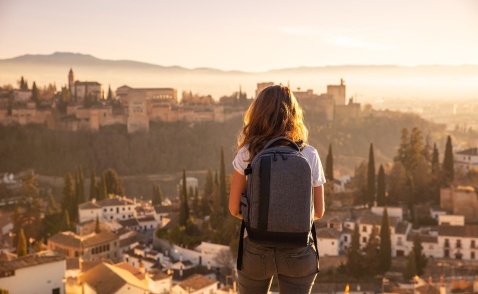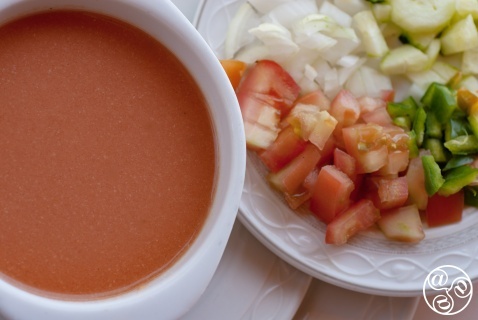
So much to see when backpacking in Andalucia. Looking over the Alhambra from Mirador de San Nicolas |
|
Backpacing in Andalucia
by Lee Gutcher, who offers advice gained from backpacking in andalucia.
Introduction
Andalucia has everything to offer the budget traveller.
Architecture
The Alhambra (Granada) and the Mosque-church (Cordoba) are truly world-class monuments amongst a host of other fascinating castles, cathedrals and churches.
History
From prehistoric cave paintings through the Phoenicians, Carthaginians, Greeks, Romans and the Moors - all have left a rich historical mark on the region. More about history.
Culture
Andalucia is the home of bullfighting and flamenco, has the most famous fiestas and it's people are perhaps the most quintessentially Spanish. More about culture.
Beaches
The resorts of the Costa del Sol and white sandy unspoiled beaches of the Costa de Luz are possible destinations to relax and unwind.
With plentiful accommodation, inexpensive but excellent food and with cheap carriers such as Easyjet and Ryanair operating through the principal airport of Malaga, Andalucia makes a wonderful budget travel destination. Flights to Andalucia.
Accommodation
Finding reasonably priced accommodation in Andalucia is rarely a problem, and booking ahead is not necessary unless there is a feria in town. During the large ferias it will be impossible to find a room anywhere in town. And even during the smaller ferias you may struggle unless you book ahead. There are a surprisingly large number of these ferias and you are very likely to stumble upon them even if you plan not to. They do result in higher room prices, but no trip to Andalucia would be complete without experiencing the energy and colour of these fabulous events.
Hostelworld lists hundreds of hostels in all the cities of Andalucia, including Seville, Cádiz, Granada, Málaga, Almería and Córdoba, as well as interesting towns such as Ronda, Guadix, Antequera and Algeciras, and coastal resorts such as the Costa de la Luz (Conil and Tarifa), the Costa del Sol (Estepona, Marbella and Nerja).
Double rooms will start from 40€ but expect to pay from 75€ or more depending on the location and the quality of the hostel. More hostels and hostals.
Single rooms can be found, normally for 35€ and upwards. Single rooms are not widely available, but often by bargaining you can get a double room for the price of a single. This is due to the oversupply of accommodation, but will not work during busy periods, and especially during ferias. Expect to pay a little extra in Seville and probably Granada.
Many of the larger cities do have Youth Hostels, but arrive early, especially in mid to high season if you want to get a bed.
As a rule of thumb it is a good idea to head to the Cathedral of the city, which will be in the old quarter, and will almost always be the an excellent place to look for inexpensive hostels. And finally, don't be afraid to haggle -- over time, it will save you a great deal of money. Some hostel owners expect it.
Getting Around
Getting around Andalucia is rarely a problem as it is well covered by bus and rail networks.
The price difference of coaches and trains is minimal but generally coaches are faster, and run more frequently. So unless you're travelling with a rail pass it is preferable to rely on coaches rather than trains.
RENFE, the Spanish rail company has a hugely complicated system of different services and ticket types. Coaches, especially those running between the major cities are comfortable, quick and reliable, certainly by Spanish standards. Fares are reasonable and will not destroy your budget. About Busses in Andalucia.
There are a high speed train (AVE) which run between Malaga, Granada, & Seville to Cordoba, and onto Madrid. Prices are double normal fares but the time saved is significant. since 2023 there have been low cost high speed trains.
Often it is difficult to find your way around Spanish cities. Although Turismo offices will happily provide you with a detailed map, orientation can be difficult due to Spanish reluctance to use signposts. Also a lot of Spanish streets can have more than one name, which can lead to confusion.
Day to Day
Food and Drink
Spanish cuisine is of a high standard and very reasonable. One of the best ways to sample the cuisine is to have a succession of tapas (small snacks). Moving between bars and experimenting with different tapas is also an excellent way to socialise, as it is a popular pastime for the Spanish. Often bars and restaurants will have a range of tapas dishes on display at the counter and you can order by pointing. Typically a tapa in a tapas bar will cost 1.50 - 3.50 euro unless you frequent the flashier establishments or order specialities.
A large number of restaurants will have a Menu del Dia. This is normally a basic 3 course meal, typically being gazpacho soup, fried fish and fruit with drink and bread. Although basic, these meals are filling and cost as little as 10 euro. Often restaurants will have more expensive Menu del Dia's or Plato Combinado which allow you to try more interesting dishes. Wherever you go fish is likely to be superb.
Spanish Customs
There are a couple of Spanish traditions a foreign traveller should consider in order to enjoy their stay. Firstly is the relaxed attitude of the Spanish to customer service. Expect long waits in shops, bars and restaurants, as the Spanish will make no effort to rush to your needs. It's easy to think of this as ignorance but it is more a way of Spanish life; they would rather enjoy themselves than earn a tip. However it doesn't matter how long you spend in the country though, you will never fully come to terms with this.
Another point to remember is Spanish opening hours. Most shops close on Sundays, on Saturdays after 2.00pm and all week during siesta period (2.00pm - 4.30pm) These and other Spanish customs have to be embraced otherwise you can easily get frustrated and spoil your trip.
A suggested Itinerary for the backpacker.



